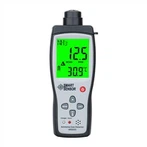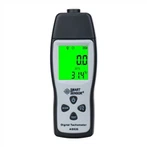A low-voltage electroscope is an electrician's eye, a tool used to detect whether wires, electrical appliances and electrical equipment are charged. When the current passes through the tested electrical appliance, the human body and the earth to form a loop, its leakage current makes the neon bulb glow and work.
The principle is that the potential difference between the charged body and the earth exceeds a certain value, and the neon bulb will emit light, and if it is lower than a certain value, it will not emit light, so as to determine whether the low-voltage electrical equipment is charged.
The voltage measurement range of ordinary low-voltage electroscopes is 60--500v. Neon bulbs may not emit light if they are lower than 60v. Voltages higher than 500v must be measured with an electroscope of the corresponding voltage level to avoid electric shock accidents.
Test AC, DC and DC positive and negative
In addition to measuring whether the device is charged, the electroscope can also test AC, DC, and the positive and negative poles of DC. When using an electroscope to distinguish between AC and DC, it can be seen directly by visual inspection. The neon bulb of the direct current test pen has only one head glowing. When testing alternating current, the middle of the neon bulb will glow. When testing the positive and negative poles, connect the two ends of the electroscope between the positive and negative poles of the direct current. Another method is to use the principle of direct current flowing from the negative electrode to the positive electrode for testing. If the power supply voltage is 110v and above, if a person is isolated from the earth, touch any pole of the power supply with one hand, and hold an electroscope with the other, the metal tip of the electroscope touches the other pole of the power supply under test, and the front end (tip) of the neon bulb glows. is the negative pole, the opposite is the positive pole.
Use two electric pens to judge in-phase and out-of-phase
The way to judge whether the power supply is in-phase or out-of-phase is to stand on an object that is absolutely insulated from the ground, hold an electric pen in each hand, and touch two live wires at the same time. If they are in the same phase, the two electric pens will not emit light. If it is out of phase, the two test pens will emit light at the same time. This is because there is no potential difference between the same phase, and there is a potential difference between the different phases to generate voltage, and the current will flow between the test pen and the human body, but don’t worry. There will be electric shock. Because the resistance value in the electroscope is very large, the current flowing through the human body is very small, so the human body will not be electrocuted, although you can use it with confidence.






